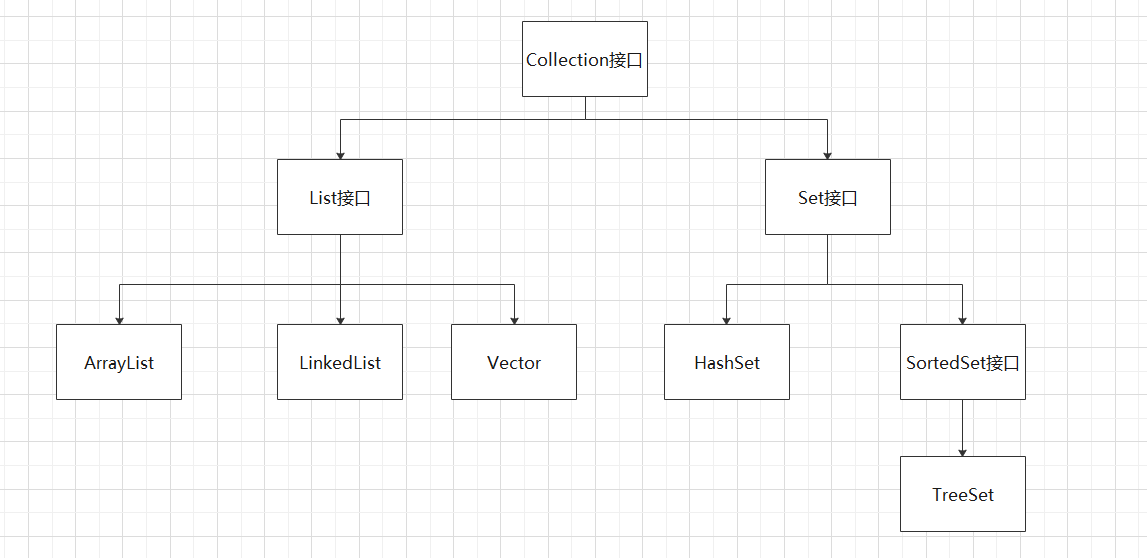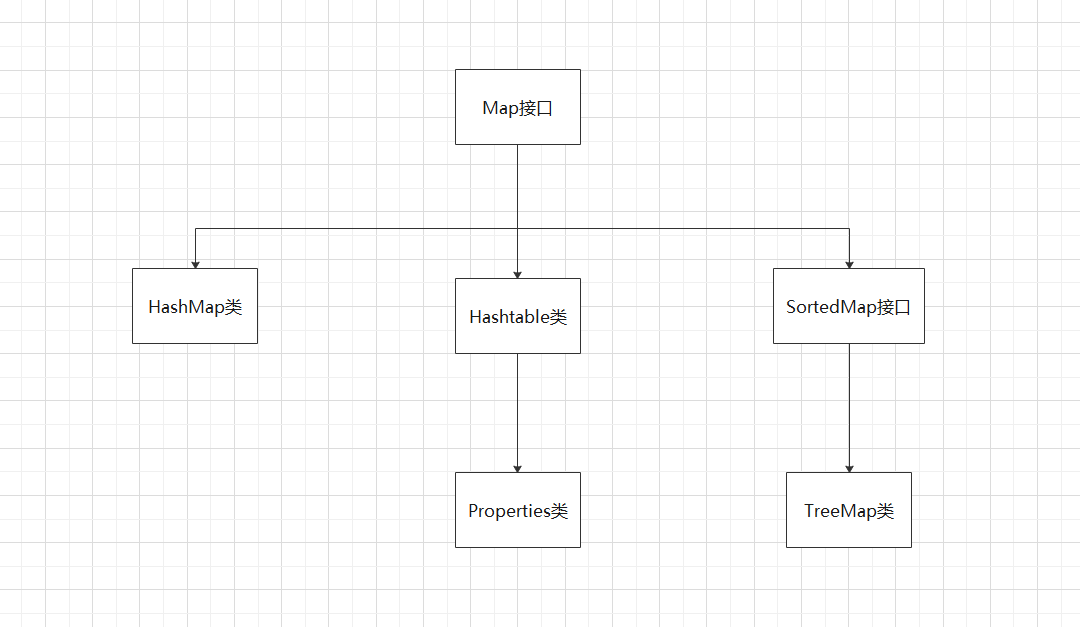Java集合框架个人总结
Java集合框架个人总结
集合主要分为两大类:①单列集合Collection ②双列集合Map
集合存储的都是引用类型,不可是基础类型,如果保存基础类型需要用包装类。
1.5 泛型 ★
单列集合Collection结构图

Collection接口
集合层次结构中的根界面 。 集合表示一组被称为其元素的对象。 一些集合允许重复元素(Lis),而其他集合不允许(Set)。 有些被命令和其他无序。 JDK不提供此接口的任何直接实现:它提供了更具体的子接口的实现,如Set和List 。 该界面通常用于传递集合,并在需要最大的通用性的情况下对其进行操作。
public class CollectionTest {
public static void main(String[] args) {
//ArrayList 是 Collection的实现类
Collection col = new ArrayList();
String c1 = "张三";
String c2 = "李四";
String c3 = "王五";
//向集合中添加元素 add方法
col.add(c1);
col.add(c2);
col.add(c3);
col.add(c2);
System.out.println(col);
System.out.println(col.size());
//判断集合是否为空和集合是否包含元素
System.out.println(col.contains(c2));
System.out.println(col.contains("王五"));
System.out.println(col.isEmpty());
System.out.println("-----------------------");
//遍历集合
//一、for each方法遍历
for (Object o : col) {
System.out.println((String)o);
//col.remove(o);
}
System.out.println(col);
System.out.println("-----------------------");
//二、Iterator 迭代器迭代遍历
Iterator it = col.iterator();
while (it.hasNext()){
System.out.println(it.next());
it.remove();
}
System.out.println("-----------------------");
col.add(new String("周六"));
System.out.println(col);
}
}
代码说明一:
添加元素add();
清除集合中所有元素clear();
删除集合中指定元素remove();
返回此集合中的元素数size();
返回此集合的迭代器iterator();
注意:在迭代过程中,不可以用remove删除元素;可以用Iterator.remove()删除当前元素。
*** 代码说明二:***
Collection col = new ArrayList(); 和后面的List list = new ArrayList();
在new一个新对象时,左边尽量使用接口(或者抽象类),以保持代码的最大灵活性。
①java是面向对象语言,面向对象一个重要的原则就是“依赖倒置原则”。依赖抽象(接口),而非具体(实现类)。List是接口,ArrayList是实现类。它允许list可以轻松地在接口的不同实现之间切换。
②List的实现类包括List,Vector,LinkedList , Stack…
使用List list = new ArrayList();你将来如果需要改成线程安全的Vector,不必注意一开始使用的是ArrayList还是Vector还是其他的实现类。而是只把创建时使用ArrayList改成Vector就行了。即List list = new Vector();
这种方法实现解耦合,大大提高代码使用的灵活性和通用性。
public class Student {
private String name;
private int age;
public String getName() {
return name;
}
public void setName(String name) {
this.name = name;
}
public int getAge() {
return age;
}
public void setAge(int age) {
this.age = age;
}
public Student() {
}
public Student(String name, int age) {
this.name = name;
this.age = age;
}
@Override
public String toString() {
return "Student{" +
"name='" + name + '\'' +
", age=" + age +
'}';
}
@Override
public boolean equals(Object o) {
if (this == o) return true;
if (o == null || getClass() != o.getClass()) return false;
Student student = (Student) o;
return age == student.age &&
Objects.equals(name, student.name);
}
}
public class CollectionTest {
public static void main(String[] args) {
//ArrayList 是 Collection的实现类
Collection col = new ArrayList();
Student s1 = new Student("张三",14);
Student s2 = new Student("李四",15);
Student s3 = new Student("王五",16);
//向集合中添加元素 add方法
col.add(s1);
col.add(s2);
col.add(s3);
System.out.println(col);
System.out.println(col.size());
//判断集合是否为空和集合是否包含元素
System.out.println(col.contains(s1));//true
System.out.println(col.contains(new Student("王五",16) ));//true
System.out.println(col.isEmpty());//false
System.out.println("-----------------------");
//遍历集合
//一、for each方法遍历
for (Object o : col) {
System.out.println(o);
// col.remove(o);
}
System.out.println(col);
System.out.println("-----------------------");
//二、Iterator 迭代器迭代遍历
Iterator it = col.iterator();
while (it.hasNext()){
System.out.println(it.next());
}
}
}
代码说明三:
用contains代码来确定某元素是否属于某个集合和remove从集合中删除某个元素的时候,是调用了该元素对象的Equals方法,如果引用对象的类(Student)中没用重写Equals方法,则默认比较对象的地址是否相同,则上述代码中System.out.println(col.contains(new Student("王五",16) ));应该返回fasle。但是在Student中,重写了Equals方法,添加了用name和age去判断是否为同一个对象,所以System.out.println(col.contains(new Student("王五",16) ));中返回了true。
List子接口(有序、有下标、元素可以重复)
除了继承了collection的所有方法外,List接口的实现类可以用下标去访问元素。
增加方法:
void add(int index, Object o) 在index位置插入对象o
boolean addAll(int index, Collection c) 讲一个集合中的元素添加到此集合中的index位置
Object get(int index) 返回集合中指定位置的元素
List subList(int fromIndex, int toIndex) 返回fromIndex和toIndex之间的集合元素
ListIterator listIterator() 返回List特有的迭代器,可以向前或者向后遍历,添加、删除、修改元素
public class ListTest {
public static void main(String[] args) {
List list = new ArrayList();
String c1 = "张三";
String c2 = "李四";
String c3 = "王五";
//向集合中添加元素 add方法
list.add(c1);
list.add(c2);
list.add(c3);
list.add(c2);
System.out.println(list.toString());
System.out.println(list.size());
//判断集合是否为空和集合是否包含元素
System.out.println(list.contains(c2));
System.out.println(list.contains("王五"));
System.out.println(list.isEmpty());
System.out.println("-----------------------");
//遍历集合
//一、使用for遍历
for (int i = 0; i < list.size(); i++) {
System.out.println(list.get(i));
}
System.out.println("-----------------------");
//二、for each方法遍历
for (Object o : list) {
System.out.println((String)o);
//col.remove(o);
}
System.out.println("-----------------------");
//三、Iterator 迭代器迭代遍历
Iterator it = list.iterator();
while (it.hasNext()){
System.out.println(it.next());
}
System.out.println("-----------------------");
//四、使用列表迭代器
ListIterator lit = list.listIterator();
while (lit.hasNext()){
System.out.println(lit.next());
}
System.out.println("-------------------------");
while (lit.hasPrevious()){
System.out.println(lit.previous());
}
System.out.println(list);
}
}
代码说明:
列表迭代器ListIterator从后向前判断时,必须先运行一边从前向后判断。
ArrayList类
数组结构实现,查询快、增删慢
jdk1.2版本,运行效率快、线程不安全
package com.company.Collection;
import java.util.ArrayList;
import java.util.Iterator;
import java.util.ListIterator;
public class ArrayTest {
public static void main(String[] args) {
ArrayList arrayList = new ArrayList();
//1.添加元素
Student s1 = new Student("张三",14);
Student s2 = new Student("李四",15);
Student s3 = new Student("王五",16);
arrayList.add(s1);
arrayList.add(s2);
arrayList.add(s3);
System.out.println("元素个数:"+arrayList.size());
System.out.println(arrayList.toString());
//2.删除元素
arrayList.remove(s1);
System.out.println("元素个数:"+arrayList.size());
System.out.println(arrayList.toString());
//3.遍历元素
//3.1使用迭代器
System.out.println("3.1使用迭代器");
Iterator it = arrayList.iterator();
while (it.hasNext()){
System.out.println(it.next());
}
//3.2使用列表迭代器
System.out.println("3.2使用列表迭代器");
ListIterator lit = arrayList.listIterator();
while (lit.hasNext()){
System.out.println(lit.next());
}
//4判断
System.out.println(arrayList.contains(new Student("王五",16)));
System.out.println(arrayList.isEmpty());
//5查找
System.out.println(arrayList.indexOf(new Student("王五",16)));
System.out.println(arrayList.get(1));
}
}
源码分析:
ArrayList:
默认容量:DEFAULT_CAPACITY = 10; 注意:如果没用向集合中添加任何元素,容量为0。添加任意一个元素之后,容量为10。每次扩容都为原来容量的1.5倍。
存放元素的数组:elementData;
实际元素格式:size;
add添加元素:
public boolean add(E e) {
ensureCapacityInternal(size + 1); // Increments modCount!!
elementData[size++] = e;
return true;
}
private void ensureCapacityInternal(int minCapacity) {
if (elementData == DEFAULTCAPACITY_EMPTY_ELEMENTDATA) {
minCapacity = Math.max(DEFAULT_CAPACITY, minCapacity);//10
}
ensureExplicitCapacity(minCapacity);
}
private void ensureExplicitCapacity(int minCapacity) {
modCount++;
// overflow-conscious code
if (minCapacity - elementData.length > 0)
grow(minCapacity);
}
private void grow(int minCapacity) {
// overflow-conscious code
int oldCapacity = elementData.length;
int newCapacity = oldCapacity + (oldCapacity >> 1);
if (newCapacity - minCapacity < 0)
newCapacity = minCapacity;
if (newCapacity - MAX_ARRAY_SIZE > 0)
newCapacity = hugeCapacity(minCapacity);
// minCapacity is usually close to size, so this is a win:
elementData = Arrays.copyOf(elementData, newCapacity);
}
Vector
数组结构实现,查询快、增删慢;
JDK1.0版本,运行效率慢、线程安全。
目前开发使用不多,了解即可。
package com.company.Collection;
import java.util.Enumeration;
import java.util.Vector;
public class VectorTest {
public static void main(String[] args) {
Vector vector = new Vector();
vector.add("北京");
vector.add("上海");
vector.add("深圳");
//遍历
//枚举器
Enumeration en = vector.elements();
while (en.hasMoreElements()){
System.out.println(en.nextElement().toString());
}
//判断
System.out.println(vector.contains("上海"));
//其他方法
System.out.println(vector.firstElement());
System.out.println(vector.lastElement());
}
}
LinkedList
链表结构实现,增删快,查询慢。
存储结构:双向链表。
package com.company.Collection;
import java.util.Iterator;
import java.util.LinkedList;
import java.util.ListIterator;
public class LinkedListTest {
public static void main(String[] args) {
LinkedList linkedList = new LinkedList();
//1.添加元素
Student s1 = new Student("张三",14);
Student s2 = new Student("李四",15);
Student s3 = new Student("王五",16);
linkedList.add(s1);
linkedList.add(s2);
linkedList.add(s3);
System.out.println(linkedList.size());
System.out.println(linkedList.toString());
//2.删除元素
// linkedList.remove(s2);
// linkedList.remove(new Student("王五",16));
//3.遍历
//3.1 for 循环
for (int i = 0; i < linkedList.size(); i++) {
System.out.println(linkedList.get(i));
}
//3.2 for each
for (Object o : linkedList) {
System.out.println(((Student)o).toString());
}
//3.3使用迭代器
Iterator it = linkedList.iterator();
while (it.hasNext()){
System.out.println(it.next());
}
//3.4 使用列表迭代器
ListIterator lit = linkedList.listIterator();
while (lit.hasNext()){
System.out.println(lit.next());
}
while (lit.hasPrevious()){
System.out.println(lit.previous());
}
//4 判断
System.out.println(linkedList.contains(s2));
//5 获取
System.out.println(linkedList.indexOf(s1));
System.out.println(linkedList.get(linkedList.indexOf(s1)));
}
}
泛型
泛型类
package com.company.MyGeneric;
/**
* 泛型类
* 语法:类名<T>
* T是占位符,表示一种类型,如果编写多个使用逗号隔开
*/
public class MyGeneric<T>{
//使用泛型T
//1.创建变量
T t;
//2.作为方法的参数
public void show(T t){
System.out.println(t);
}
//3.作为方法的返回值
public T getT(){
return t;
}
}
public class TestGeneric {
public static void main(String[] args) {
MyGeneric<String> myGeneric= new MyGeneric<>();
myGeneric.t="hello";
myGeneric.show("123dadas");
System.out.println(myGeneric.getT());
MyGeneric<Integer> myGeneric2 = new MyGeneric();
myGeneric2.t = 100;
myGeneric2.show(200);
System.out.println(myGeneric2.getT());
}
}
1.泛型只能是引用类型
2.不同泛型类型对象之间不能相互赋值
MyGeneric<Integer> myGeneric3 = myGeneric; //错误的赋值
泛型接口
1.泛型接口的数据类型可以在实现类定义的时候确定
2.泛型接口的数据类型也可以在使用实现类的时候确定
package com.company.MyGeneric;
public interface MyInterface <T>{
String name = "张三";
T server(T t);
}
package com.company.MyGeneric;
public class MyImpl implements MyInterface<String>{
@Override
public String server(String s) {
System.out.println(s);
return s;
}
}
package com.company.MyGeneric;
public class MyImpl2<T> implements MyInterface<T>{
@Override
public T server(T t) {
System.out.println(t.toString());
return t;
}
}
package com.company.MyGeneric;
import com.company.Collection.Student;
public class TestGeneric {
public static void main(String[] args) {
MyImpl my = new MyImpl();
my.server("asdada");
MyImpl2<Student> myImpl2 = new MyImpl2();
myImpl2.server(new Student("李狗",20));
}
}
泛型方法
package com.company.MyGeneric;
public class MyGenericMethod {
//泛型方法
public <T> T show(T t){
System.out.println("泛型方法");
System.out.println(t);
return t;
}
}
package com.company.MyGeneric;
import com.company.Collection.Student;
public class TestGeneric {
public static void main(String[] args) {
MyGenericMethod myGenericMethod = new MyGenericMethod();
myGenericMethod.show(new Student("Dog",23));
}
}
泛型好处
(1)提高代码的重用性
(2)防止类型转换异常,提高代码的去安全性
泛型集合
概念:参数化类型、类型安全的集合,强制集合元素的类型必须一种。
特点:
- 编译时即可检查,而非运行时抛出异常
- 访问时,不必类型转换(拆箱)
- 不同泛型之间引用不能相互赋值,泛型不存在多态
package com.company.Collection;
import java.util.ArrayList;
public class ArrayListTest {
public static void main(String[] args) {
ArrayList<String> arrayList = new ArrayList<>();
arrayList.add("hello");
arrayList.add("OkFine");
// arrayList.add(123456);
// arrayList.add(new Student("Dog",20));
for (String s : arrayList) {
System.out.println(s);
}
}
}
Set接口
特点:无序、无下标、元素不可重复
package com.company.Collection;
import java.util.HashSet;
import java.util.Iterator;
import java.util.Set;
public class SetTest {
public static void main(String[] args) {
Set<String> set = new HashSet<>();
//1. 添加数据
set.add("苹果");
set.add("香蕉");
set.add("菠萝");
System.out.println(set.size());
System.out.println(set.toString());
//2.删除数据
set.remove("香蕉");
System.out.println(set.toString());
//3. 遍历【重点】
//3.1使用增强for
for (String s : set) {
System.out.println(s);
}
//3.2 使用迭代器
Iterator<String> it = set.iterator();
while (it.hasNext()){
System.out.println(it.next());
}
//判断
System.out.println(set.contains("菠萝"));
}
}
HashSet
- 基于HashCode实现元素不重复
- 当存入元素的哈希码相同时,会调用equals进行确认,如结果为true,则拒绝后者存入
存储结构:哈希表(数组+链表+红黑树)
package com.company.Collection;
import java.util.HashSet;
public class HashSetTest {
public static void main(String[] args) {
//新建集合
HashSet<String> hashSet = new HashSet<>();
hashSet.add("Dog");
hashSet.add("Cat");
hashSet.add("Pig");
System.out.println(hashSet.size());
System.out.println(hashSet.toString());
//遍历 【同Set】
//3.1增强for
//3.2迭代器
//4 判断
System.out.println(hashSet.contains("Cat"));
}
}
HashSet存储过程:
- 根据HashCode计算保存的位置,如果位置为空,则之间保存,如果不为空,则执行第二部
- 再执行equals方法,如果equals 方法为true,则认为是重复的,否者形成链表
package com.company.Collection;
import java.util.Objects;
public class Student {
private String name;
private int age;
public String getName() {
return name;
}
public void setName(String name) {
this.name = name;
}
public int getAge() {
return age;
}
public void setAge(int age) {
this.age = age;
}
public Student() {
}
public Student(String name, int age) {
this.name = name;
this.age = age;
}
@Override
public String toString() {
return "Student{" +
"name='" + name + '\'' +
", age=" + age +
'}';
}
@Override
public boolean equals(Object o) {
if (this == o) return true;
if (o == null || getClass() != o.getClass()) return false;
Student student = (Student) o;
return age == student.age &&
Objects.equals(name, student.name);
}
@Override
public int hashCode() {
int n1 = this.name.hashCode();
int n2 = this.age;
return n1+n2;
}
}
package com.company.Collection;
import java.util.HashSet;
public class HashSetTest2 {
public static void main(String[] args) {
HashSet <Student> hashSet = new HashSet<>();
Student s1 = new Student("张三",23);
Student s2 = new Student("李四",24);
Student s3 = new Student("王五",25);
hashSet.add(s1);
hashSet.add(s2);
hashSet.add(s3);
hashSet.add(new Student("王五",25));
System.out.println(hashSet.size());
System.out.println(hashSet.toString());
}
}
TreeSet
存储结构:红黑树
- 基于排序顺序实现元素不重复
- 实现了SortedSet接口,对集合元素自动排序
- 元素对象的类型必须实现Comparable接口,指定排序规则
- 通过CompareTo方法确定是否为重复元素
package com.company.Collection;
import java.util.TreeSet;
public class TreeSetTest {
public static void main(String[] args) {
TreeSet<String> treeSet = new TreeSet<>();
treeSet.add("xyz");
treeSet.add("abc");
treeSet.add("qwe");
System.out.println(treeSet.size());
System.out.println(treeSet.toString());
//遍历 1.使用增强for 2.使用迭代器 同Set
//判断
System.out.println(treeSet.contains("abc"));
}
}
TreeSet使用时,需要满足以下两点中的任一点
- TreeSet集合内的元素实现Comparable接口
package com.company.Collection;
import java.util.Objects;
public class Student implements Comparable<Student>{
private String name;
private int age;
public String getName() {
return name;
}
public void setName(String name) {
this.name = name;
}
public int getAge() {
return age;
}
public void setAge(int age) {
this.age = age;
}
public Student() {
}
public Student(String name, int age) {
this.name = name;
this.age = age;
}
@Override
public String toString() {
return "Student{" +
"name='" + name + '\'' +
", age=" + age +
'}';
}
@Override
public boolean equals(Object o) {
if (this == o) return true;
if (o == null || getClass() != o.getClass()) return false;
Student student = (Student) o;
return age == student.age &&
Objects.equals(name, student.name);
}
@Override
public int hashCode() {
int n1 = this.name.hashCode();
int n2 = this.age;
return n1+n2;
}
//先必n2再比n1
@Override
public int compareTo(Student o) {
int n1 = this.getName().compareTo(o.getName());
int n2 = this.age-o.age;
return n1==0?n2:n1;
}
}
package com.company.Collection;
import java.util.TreeSet;
public class TreeSetTest {
public static void main(String[] args) {
TreeSet<Student> treeSet = new TreeSet<>();
Student s1 = new Student("张三",23);
Student s2 = new Student("李四",24);
Student s3 = new Student("王五",25);
treeSet.add(s1);
treeSet.add(s2);
treeSet.add(s3);
System.out.println(treeSet.size());
}
}
- 实现定制比较Comparator(比较器)
package com.company.Collection;
import java.util.Comparator;
import java.util.TreeSet;
public class TreeSetTest {
public static void main(String[] args) {
TreeSet<Student> treeSet = new TreeSet<>(new Comparator<Student>() {
@Override
public int compare(Student o1, Student o2) {
int n1 = o1.getAge()-o2.getAge();
int n2 = o1.getName().compareTo(o2.getName());
return n1==0?n2:n1;
}
});
Student s1 = new Student("张三",23);
Student s2 = new Student("李四",24);
Student s3 = new Student("王五",25);
treeSet.add(s1);
treeSet.add(s2);
treeSet.add(s3);
System.out.println(treeSet.size());
}
}
Map父接口

-
特点:存储一堆数据(key-Value),无序,无下标,键不可重复,值可重复。
-
方法:
- V put(K Key, V value)//将对象存入到集合中
- Object get(Object key) //根据键获取对应的值
- Set<K> //返回所有的key
- Collection<K> values() //返回包含所有值的Collection集合。
- Set<Map.Entry<K,V>> //键值匹配的Set集合
遍历时EntrySet效率高于Set
package com.company.Collection;
import java.util.HashMap;
import java.util.Map;
import java.util.Set;
public class MapTest {
public static void main(String[] args) {
Map<String,String> map = new HashMap<>();
map.put("China", "中国");
map.put("America", "美国");
map.put("Uk", "英国");
System.out.println(map.size());
System.out.println(map.toString());
//遍历
//1.使用ketSet()
Set<String> set = map.keySet();
for (String s : set) {
System.out.println(s+"="+map.get(s));
}
//2.使用entrySet()
Set<Map.Entry<String,String>> entries = map.entrySet();
for (Map.Entry<String, String> entry : entries) {
System.out.println(entry.getKey()+"="+entry.getValue());
}
}
}
HashMap
jdk1.2版本,线程不安全,运行效率快;允许使用null作为key或者是value。
默认加载容量15,默认加载因子0.75
使用Key的hashcode和equals作为重复
package com.company.Collection;
import java.util.HashMap;
public class HashMapTest {
public static void main(String[] args) {
HashMap<Student,String> students = new HashMap<>();
Student s1 = new Student("张三",23);
Student s2 = new Student("李四",24);
Student s3 = new Student("王五",25);
students.put(s1, "北京");
students.put(s2, "上海");
students.put(s3, "深圳");
students.put(new Student("王五",25),"深圳");
System.out.println(students.size());
System.out.println(students.toString());
}
}
Student类中重新了hashcode和equals函数,以年龄和姓名的值作为比较是否相同。上面程序输出:
3
源码分析
- HashMap刚创建时,table是null,为了节省空间,当添加第一个元素时,table容量调整为16
- 当元素个数大于阈值(16-0.75)=12时,会进行扩容,扩容大小为原来的2倍。目的是减少调整元素的个数。
- jdk1.8,当每个链表长度大于8,并且数组元素个数大于64时,会调整为红黑树,目的是提高执行效率
- jdk1.8,当链表长度小于6时,调整成链表
- jdk1.8以前,链表是头插入,jdk1.8以后是尾插入
Hashtable
- JDK1.0版本,线程安全,运行效率慢;不允许null作为key或是value。
目前用的不多。
Properties
- Hashtable的子类,要求key和value都是String。通常用于配置文件的读取。
主要用于流的操作。
TreeMap
- 实现了SortedMap接口(是)Map的子接口,可以对Key自动排序。
package com.company.Collection;
import java.util.Comparator;
import java.util.Map;
import java.util.Set;
import java.util.TreeMap;
public class TreeMapTest {
public static void main(String[] args) {
TreeMap<Student,String> students = new TreeMap<>(new Comparator<Student>() {
@Override
public int compare(Student o1, Student o2) {
int n2 = o1.getAge()-o2.getAge();
int n1 = o1.getName().compareTo(o2.getName());
return n1==0?n2:n1;
}
});
Student s1 = new Student("张三",23);
Student s2 = new Student("李四",24);
Student s3 = new Student("王五",25);
students.put(s1, "北京");
students.put(s2, "上海");
students.put(s3, "深圳");
System.out.println(students.size());
System.out.println(students.toString());
//遍历
//1.keyset遍历
Set<Student> set = students.keySet();
for (Student student : set) {
System.out.println(student+"="+students.get(student));
}
//2.entryset()遍历
Set<Map.Entry<Student,String>> entries=students.entrySet();
for (Map.Entry<Student, String> entry : entries) {
System.out.println(entry.getKey()+"="+entry.getValue());
}
}
}
Collections工具类
package com.company.Collection;
import java.lang.reflect.Array;
import java.util.*;
public class CollectionsTest {
public static void main(String[] args) {
List<Integer> list = new ArrayList<>();
list.add(200);
list.add(250);
list.add(300);
list.add(12);
System.out.println("排序之前"+list.toString());
Collections.sort(list);
System.out.println("排序之后"+list.toString());
//二分查找
int i = Collections.binarySearch(list, 200);
System.out.println(i);
//负值
List<Integer> list1 = new ArrayList<>();
for (int i1 = 0; i1 < list.size(); i1++) {
list1.add(0);
}
Collections.copy(list1, list);
System.out.println(list1.toString());
//反转
Collections.reverse(list);
System.out.println("反转之后"+list.toString());
//打乱
Collections.shuffle(list);
System.out.println("打乱之后"+list.toString());
//补充:list转为数组
Integer[] i1 = list.toArray(new Integer[0]);
System.out.println(i1.length);
System.out.println(Arrays.toString(i1));
//数组变为集合
String[] names = {"张三","李四","王五"};
List<String> list2 = Arrays.asList(names);
//集合是一个受限集合,不能添加删除
System.out.println(list2);
}
}




